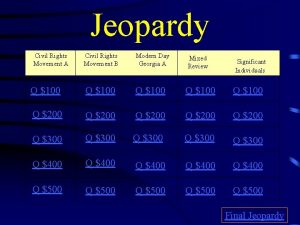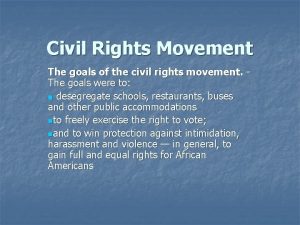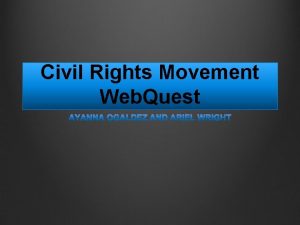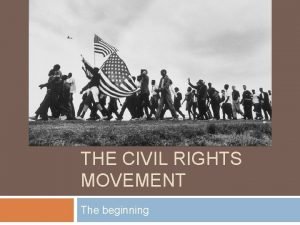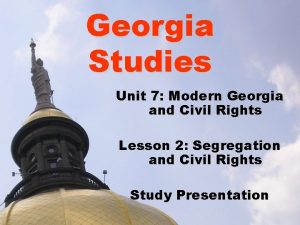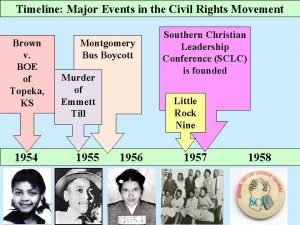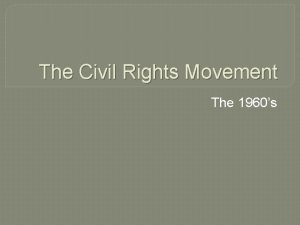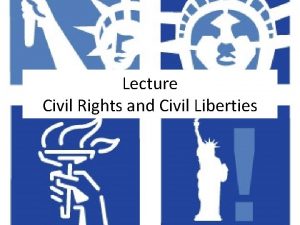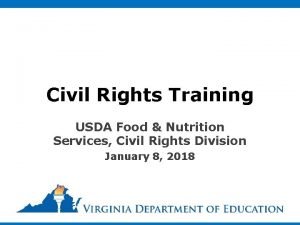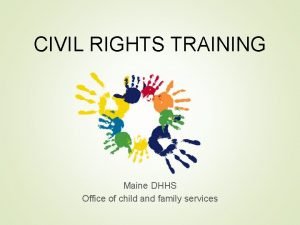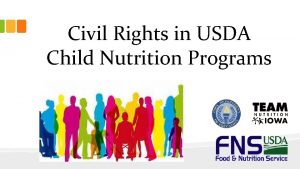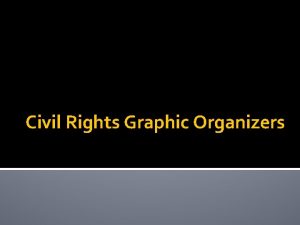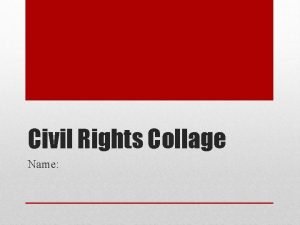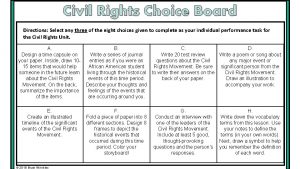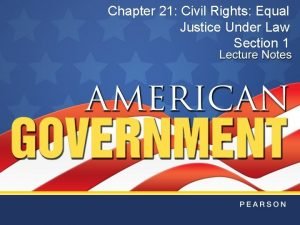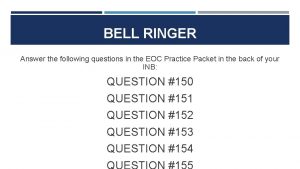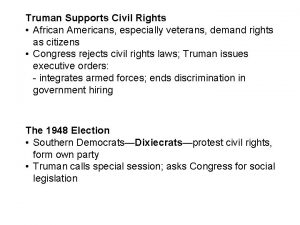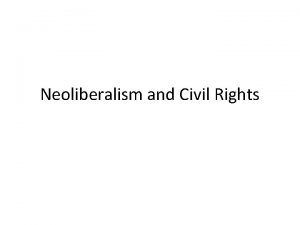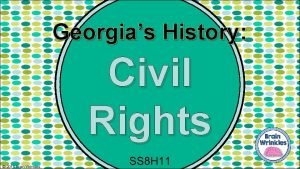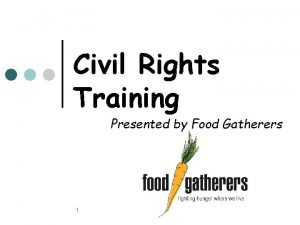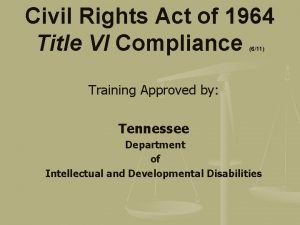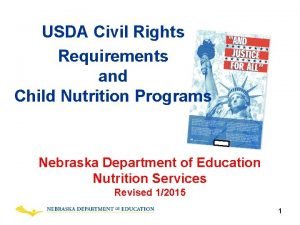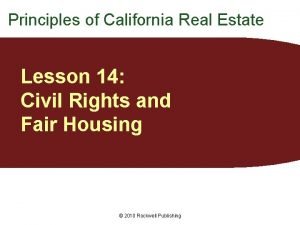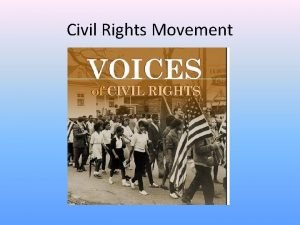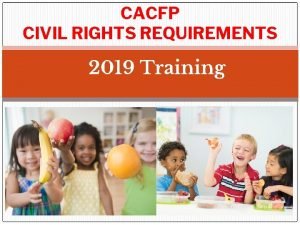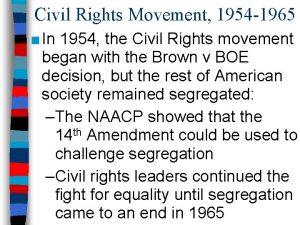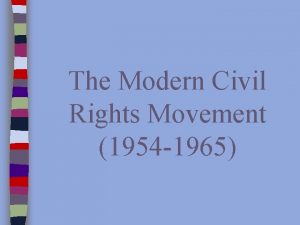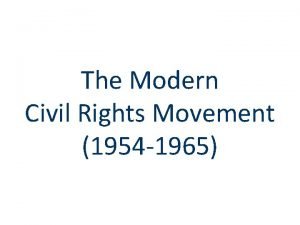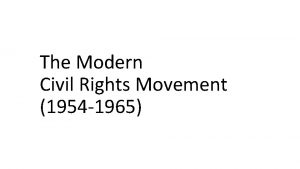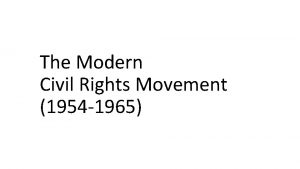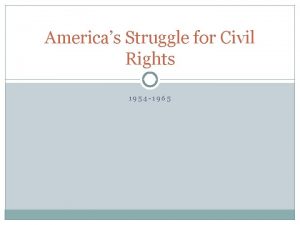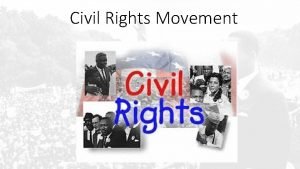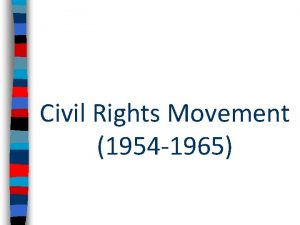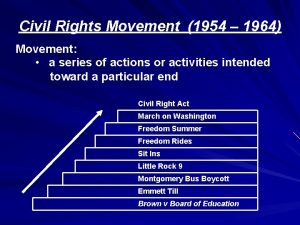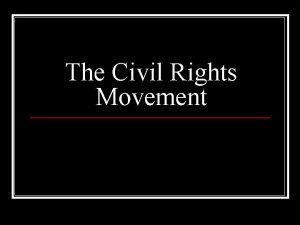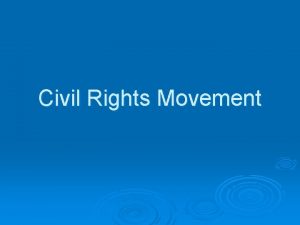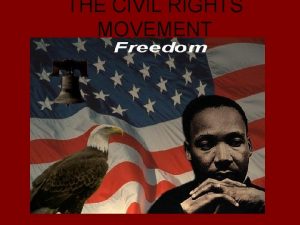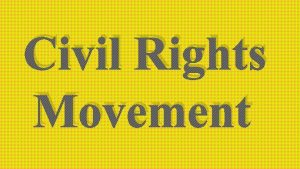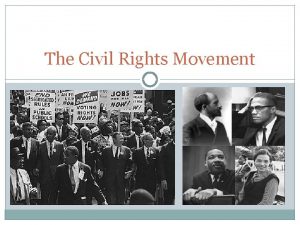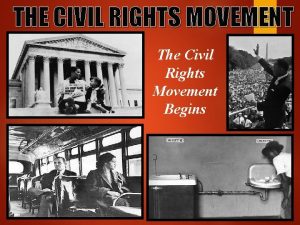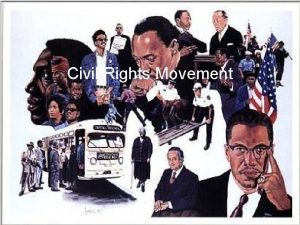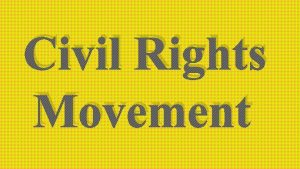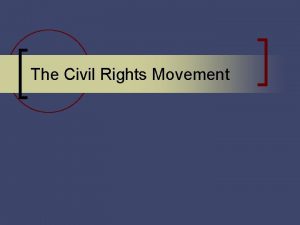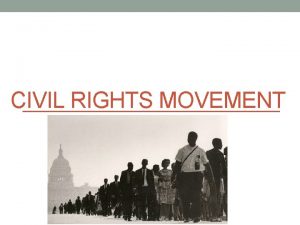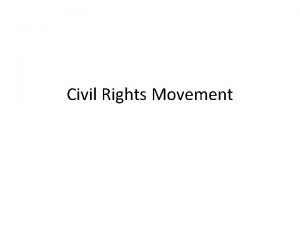The Modern Civil Rights Movement 1954 1965 Two































- Slides: 31

The Modern Civil Rights Movement (1954 -1965)

Two kinds of segregation • de jure segregation § Segregation by law • Common in the South • Laws forbid African. Americans from attending the same church, using the same swimming pool, eating in restaurants, or marrying White people. • de facto segregation § Segregation without laws • Common in the North • Housing discrimination made segregation in the North. • White community groups did not allow non-Whites to live in White neighborhoods. • Every ethnic group had its own part of town.

The Modern Civil Rights Movement (1950 s)

The. Segregated Struggle school Over districts Civil Rights spend 10 times more on white students than black students • The modern Civil Rights movement NAACP began in 1954 attorneys with the successfully Supreme Court challenged discrimination in university decision Brown v Board of Education admissions for graduate programs too of Topeka, Kansas • The NAACP took the lead in civil rights; Segregated schools became their primary target • Their strategy was to use lawsuits to challenge that segregation violated the 14 th Amendment

Brown v. Board of Education (1954) The Topeka school district denied Linda Brown from attending a white school 4 blocks from her house • NAACP lawyer Thurgood Marshall used the 14 th Amendment to attack public school segregation • Marshall argued that even “equal” schools, if separate, imply that black children are inferior to whites

Brown v. Board of Education (1954) ■ The Supreme Court’s unanimous decision ruled “separate facilities are inherently unequal” – Chief Justice Earl Warren stated that segregation violated the “equal protection clause” of the 14 th Amendment – The decision overturned the Plessy v Ferguson (1896) “separate but equal” precedent

Thurgood Marshall & his NAACP legal team Thurgood Marshall’s success in Brown made him the most famous black lawyer in the U. S. ; In 1967, he became the 1 st black justice appointed to the Supreme Court Linda Brown

■ Brown decision ■ “All deliberate speed” ■ Significant integration did not begin until mid/late 1960 s

Resistance to Brown “The people of Georgia will not comply with the decision of the court… We're going to do whatever is necessary in Georgia to keep white children in white schools and colored children in colored schools. "

Songs of the Civil Rights Movement In the song lyrics, what does “the prize” refer to?

Desegregating schools is not so easy! • In 1957, President Eisenhower was forced to support integration of schools • Arkansas governor Orval Faubus called the National Guard to keep black students from enrolling in Little Rock’s Central High School! • Eisenhower sent the Army to force integration for the black students (the “Little Rock Nine”) Clip

Integrating Central High School in Little Rock, Arkansas (1957) The “Little Rock Nine” Arkansas Governor Orval Faubus

December 1, Rosa Parks refused to give up her seat on a bus What did Rosa Parks refuse to do that led to the situation shown in the picture?

Montgomery Bus Boycott (1955) • Rosa Parks’ actions transformed the movement • NAACP began preparing a legal challenge • Rise of Martin Luther King Jr. : urged non-violence • SCLC • Bus boycott lasted a YEAR! • In 1956 the Supreme Court ruled the Montgomery bus segregation law was unconstitutional “Freedom is never voluntarily given by the oppressor; it must be demanded by the oppressed. ”

The Modern Civil Rights Movement (1960 s)

Sit-ins and Freedom Rides • Greensboro, North Carolina sit-in (February 1, 1960) • 4 black students sat at a segregated counter of a Woolworth’s 5 and Dime Store • As the week progressed, more students joined in • Inspired sit-ins across the country • Congress of Racial Equality (CORE) • “Freedom riders” wanted to challenge segregation on interstate buses in the South • Wanted to force the Justice Department to enforce desegregation laws • Birmingham, Alabama • Freedom Riders were attacked by a white mob • September, 1961 – ICC enforced the ban on segregation VIDEO

Focus shift to Birmingham, Alabama Martin Luther King, Jr. • Arrested for protesting • Letter from Birmingham Jail (1963) • Drew on Thoreau’s and Gandhi’s ideas of civil disobedience • “an individual who breaks a law that conscience tells him is unjust, and who willingly accepts the penalty of imprisonment in order to arouse the conscience of the community over its injustice, is in reality expressing the highest respect for law. ”

What were GOALS of this movement?

King’s March on Washington (August, 1963) • To put pressure on Congress to pass the new civil rights bill • Drew more than 200, 000 • MLK- “I have a dream” speech • One of the largest political demonstrations • A model for peaceful protest

MLK Jr. and Malcolm X • MLK Jr. : • • • Civil disobedience Believed black could be American AND African Major goal was desegregation “Love thy enemy” Like WEB Du. Bois • Malcolm X: • Born Malcolm Little, became a member of the Nation of Islam • Advocated “black revolution” and black separatism – Black Muslims • Appealed to frustrated African Americans • “The ballot or the bullet” – DIRECT ACTION • Like Booker T. Washington

Civil Rights Act of 1964 1) Same requirements for black & white voters 2) Prohibits discrimination in public accommodations 3) Withholding of federal funds from discriminatory programs and businesses 4) Bans discrimination based on race, sex, religion and national origin by employers & unions; creates EEOC

Voting Rights Act of 1965 • Federal officials may register voters when local offices block African Americans • Eliminated literacy tests

Important Organizations to know… • Southern Christian Leadership Conference (SCLC) • Student Nonviolent Coordinating Committee (SNCC) • Helped register blacks to vote in Mississippi (5% were registered in 1964) • Later, under the leadership of Stokely Carmichael, SNCC focused on black power • Black Panthers (1966): • Advocated the arming of blacks against white police

How did the African American freedom struggle influence other social movements of the 20 th century? On your worksheet packets

KING, In view of your low grade. . . I will not dignify your name with either a Mr. or a Reverend or a Dr. And, your last name calls to mind only the type of King such as King Henry the VIII. . . King, look into your heart. You know you are a complete fraud and a great liability to all of us Negroes. White people in this country have enough frauds of their own but I am sure they don't have one at this time anywhere near your equal. You are no clergyman and you know it. King, like all frauds your end is approaching. You could have been our greatest leader. You, even at an early age have turned out to be not a leader but a dissolute, abnormal moral imbecile. King, there is only one thing left for you to do. You know what it is.

King became aware that economic issues must be part of the civil rights movement. King went to Memphis, Tennessee to help striking sanitation workers. He led a march to city hall. James Earl Ray shot and killed King as he stood on the balcony of his motel. Within hours, rioting erupted in more than 120 cities. Within three weeks, 46 people were dead, some 2, 600 were injured, and more than 21, 000 were arrested.

Civil Rights Act of 1968 • Written as a follow-up to the Civil Rights Act of 1964 • Created to enforce equal housing opportunities for all races (AKA Fair Housing Act) • You cannot refuse to rent or sell a house to anyone, anywhere, based upon their race, religion, national origin, and gender (since 1974) • “a federal crime to “by force or by threat of force, injure, intimidate, or interfere with anyone … by reason of their race, color, religion, or national origin. ”

The Summer of ‘ 68 Both the Vietnam War and the anti-war movement were peaking. Martin Luther King Jr. had been assassinated in the spring, igniting riots across the country. Devoted to improving civil rights, Robert F. Kennedy (younger brother of JFK) was perceived by many to be the only person in American politics capable of uniting the people.

Racial Segregation Timeline


Could we be in a 3 rd civil rights movement TODAY? (SYNTHESIS) Ø President Obama elected as 44 th President of the US – culmination of all efforts of prior activists Ø Black Lives Matter movement Ø In response to overuse of police power post 9/11 (use of police force) Ø Eric Garner Ø Ferguson, Missouri (fatal shooting of Michael Brown)
 Mother of the modern day civil rights movement
Mother of the modern day civil rights movement Civil rights and civil liberties webquest
Civil rights and civil liberties webquest Civil rights movement jeopardy
Civil rights movement jeopardy Civil rights movement goal
Civil rights movement goal Civil rights movement vocabulary
Civil rights movement vocabulary Civil rights movement webquest
Civil rights movement webquest The civil rights movement
The civil rights movement Civil rights movement essential questions
Civil rights movement essential questions Unit 7: modern ga and civil rights
Unit 7: modern ga and civil rights Civil rights timeline of events
Civil rights timeline of events Civil rights sitins
Civil rights sitins Civil rights act of 1957 apush
Civil rights act of 1957 apush Define civil rights
Define civil rights Usda civil rights training
Usda civil rights training Civil rights training child nutrition programs
Civil rights training child nutrition programs Civil rights in child nutrition programs
Civil rights in child nutrition programs Civil rights graphic organizer
Civil rights graphic organizer Civil rights collage
Civil rights collage Civil rights choice board
Civil rights choice board Chapter 21 civil rights equal justice under law
Chapter 21 civil rights equal justice under law Chapter 20 civil liberties protecting individual rights
Chapter 20 civil liberties protecting individual rights Civil rights bell ringers
Civil rights bell ringers Truman supports civil rights
Truman supports civil rights Characteristics of civil rights
Characteristics of civil rights Civil rights cloze notes 1
Civil rights cloze notes 1 Civil rights cloze notes 1
Civil rights cloze notes 1 Federally protected classes
Federally protected classes Title vi of the civil rights act of 1964
Title vi of the civil rights act of 1964 Civil rights in child nutrition programs
Civil rights in child nutrition programs Unruh civil rights act real estate
Unruh civil rights act real estate Civil rights movment
Civil rights movment Cacfp civil rights
Cacfp civil rights


